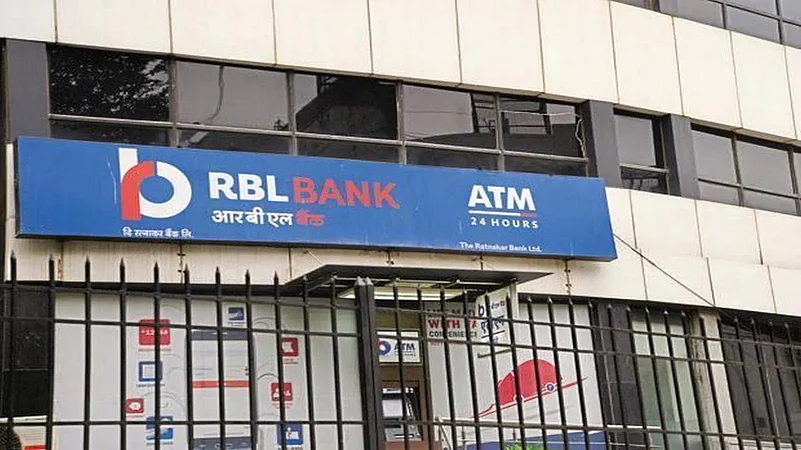Shares of RBL Bank, formerly known as Ratnakar Bank Limited, have tanked over 17 per cent in the last two sessions after the company reported a 24 per cent decline in its profit after tax (PAT) on a year-on-year (YoY) basis at Rs 223 crore.
The bank reported a miss in Q2 earnings as asset quality issues impacted key profitability segments. Asset quality ratios declined during the quarter as slippages in the credit card and microfinance segments remained high. However, deposits saw a solid growth, with the CASA (Current Account Savings Account) ratio improving sequentially and leading to a C/D (Credit-Deposit) ratio of 86.6 per cent.
Advertisement
The bank reported a 24 per cent YoY growth in its operating profit to Rs 910 crore for the reporting period. On a half-yearly basis, RBL Bank’s net profit also witnessed a marginal increase of 2 per cent YoY to Rs 594 crore and the net interest margins (NIMs) were reported at 5.04 per cent.
The CASA grew 13 per cent YoY to Rs 36,224 crore while the CASA ratio stood at 33.6 per cent. The bank’s total deposits grew 20 per cent on a yearly basis to stand at around Rs 1.08 lakh crore.
Shares of RBL Bank have given negative returns across various time intervals. In the last month, the stock delivered a negative return of 22 per cent. Over the past six months, it witnessed a significant decline of 35 per cent, indicating a strong downtrend.
Advertisement
RBL Bank stock touched its 52-week low of Rs 166.21 on Tuesday, October 22. It has corrected 44.3 per cent from its 52-week high level of Rs 300.50 hit on January 11. The stock had hit a record high of Rs 716.55 on May 28, 2019.
Credit card and microfinance challenges weigh on margins
The company’s net interest income (NII) grew 9 per cent YoY and fell 1 per cent QoQ to Rs 1,615 crore for the September quarter. NII was impacted by interest reversal from slippages and lower disbursals in high-yielding segments, the bank said in its investor presentation.
According to a report by Yes Securities, credit card and microfinance exposures pose a dual problem for RBL Bank. Gross slippages spiked further from already elevated levels due to credit cards and microfinance stress.
On the non-performing asset (NPA) front, the gross NPA ratio improved to 2.88 per cent in the September quarter compared to 3.12 per cent in the same quarter of the previous fiscal. The net NPA ratio stood at 0.79 per cent against 0.78 per cent in the second quarter.
Gross NPA additions amounted to Rs 10.26 billion for the September quarter, translating to an annualized slippage ratio of 4.8 per cent for the quarter. Gross NPA additions amounted to Rs 7.20 billion during Q1FY25. Credit Card slippages stood at Rs 6.3 billion and Microfinance slippages stood at Rs 2.8 billion.
Advertisement
“The key reason for higher slippages on the credit card portfolio was the transition of collection effort, which got completed by 31st July. Hence, credit card slippages have peaked and will decline from 3Q itself and there would be a reversion to earlier levels by the fourth quarter. However, credit cost on the microfinance portfolio is likely to move up in third quarter. Overall credit cost may not sharply decline in third quarter but would move lower in fourth quarter,” according to the report.
On a sequential basis, the margins declined sharply due to interest reversals and lower interest on income tax refunds. NIM came in at 5.04 per cent, down by 63 basis points from previous quarter.
Advertisement
Higher than trend slippages in credit cards and MFI led to interest reversals worth Rs 1,200 crore for the quarter. Lower interest on income tax refunds also impacted margins, adjusted for which the margin decline would have been lower at 35-40 bps QoQ. Margin in third quarter is expected to be flattish on a sequential basis before improvement is seen.
“We continue to see a steady growth in the focus areas of our business. We do, however, see some pressure on slippages and cards partly contributed by collection migration and to some extent in microfinance in the near term. We expect pullback on this by second half of this year,” said R Subramaniakumar, , MD & CEO of RBL Bank
Advertisement
The bank expects the slippages to be stabilized by next quarter, he added.
While both internal and external challenges have caused disruptions, the management’s long-term strategy for achieving diversified and sustainable growth is gradually materializing, according to Centrum Institutional Research.
“Looking ahead, we expect a steady improvement toward a 1.1 per cent RoA, aided by a possible interest rate-cut cycle and recovery in the MFI and credit card segments,” the brokerage firm said.
International brokerage firm Citi has slashed its target price for the stock to Rs 255 from Rs 281, citing challenges in the credit card and MFI segments.
Advertisement
“The bank's return on assets (ROA) and return on equity (ROE) were much lower than guided levels, contributing to sharp earnings miss. The higher Special Mention Account (SMA) pool in the MFI segment and lingering credit card stress have resulted in underwhelming credit costs,” said the brokerage.
Citi has lowered its earnings estimates by 15/12/9 per cent for FY25E/26E/27E, factoring in unsecured asset stress, NIM pressure, and lower-than-expected growth. It noted that the bank's current valuation of 0.7x FY26E book reflects a steep discount due to its subpar RoA/RoE profile.















 Just one email a week
Just one email a week